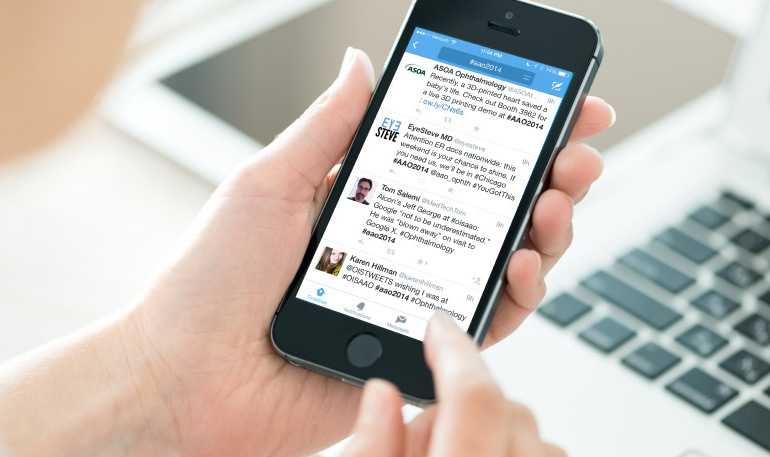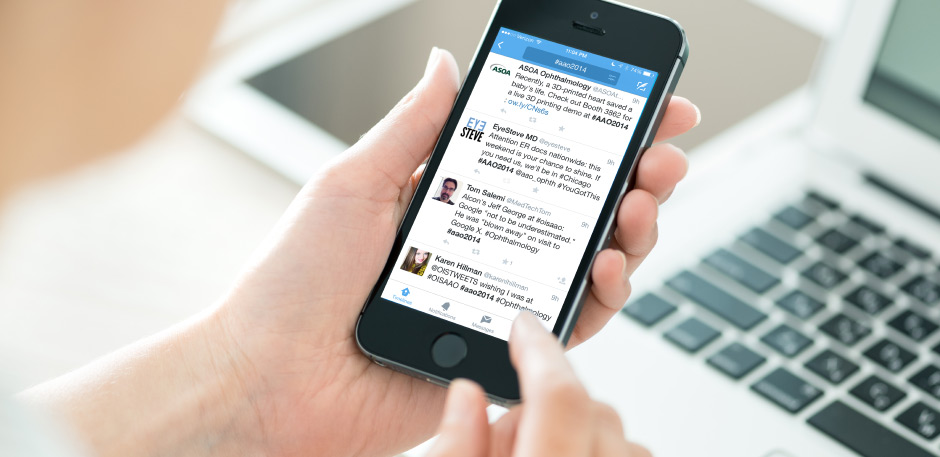This weekend I will be giving a six-minute presentation on “Twitter” to my ophthalmology colleagues at the American Academy of Ophthalmology Annual Meeting in Chicago.
That’s right. I will have exactly 360 seconds to encourage my colleagues to join the Twitter conversation. Having attended this exact session last year, I know already that this self-selected audience of listeners will come from a variety of social-media and Twitter backgrounds, with representation from the Millennial resident ophthalmologist who has used Twitter since high-school, the mid-career ophthalmologist considering Twitter as a method to promote their growing practice, and even the more senior ophthalmologist who wonders if it is too late to gain any substantial personal or professional benefit from Twitter.
In my remaining 330 seconds, let me tell you why ophthalmologists, at any stage in their career, should join Twitter.
1 – The e-patient – engaged, motivated, compliant
The e-patient revolution, started in 2007 by Dave deBronkart, has taken over healthcare, inspiring patients to use the internet and social media to learn as much as possible about their health. These patients, known as e-patients, are looking to physicians as sources of credible health information online. Whether it is the middle-aged woman seeking high-quality medical information for her own health or the college student trying to choose to which physician to take their grandfather for cataract surgery, your presence on Twitter will help these highly engaged e-patients find you, filling your clinic with an engaged, motivated, compliant patient population, which I think we would all agree, is every physician’s dream.
2 – To be heard you must have a voice
Have you ever sat among thousands of fans at a professional sporting event, amazed at how easily you can hear the big, burly, bearded man 30 rows behind you as he yells through his megaphone at the referees and coaches on the sideline? Why is it that he can be heard so easily? By using the megaphone, his voice is heard louder than the voices of the crowd that surrounds him. Twitter is the physician’s megaphone – it allows your voice to be heard not only by those who follow your feed, but also by their followers who see what you write via retweets. In a recent EyeSteve.com article I made a prediction for the future, stating that the greatest impact for healthcare social media in the next five years will be in Twitter’s ability to quickly mobilize leaders to influence public opinion. Just imagine if Twitter ophthalmologists joined forces on a specific day for a unified ophthalmology Twitter campaign, filling the public and news media’s Twitter feeds with content highlighting the importance of annual screening for diabetic retinopathy or the use of AREDS2 vitamins for age-related macular degeneration. The unified message would reach thousands, even tens of thousands, but to participate in the campaign and make a difference online using social media, you must first establish your online Twitter megaphone.
3 – Dust off the stethoscope and rejoin the greater healthcare conversation
When we decided to pursue ophthalmology, each of us recognized that to a certain extent we would be placing our first-love, the stethoscope, into the bottom drawer at the office, replacing it with the ophthalmoscope, only to pull out the former for infrequent systemic evaluations and preop physical exams. While many of us were thrilled to make this switch, when it comes to healthcare, we must be careful to not extraneously distance ourselves from the greater healthcare conversation. We must become engaged in healthcare-wide conversations, Tweeting our professional opinions on healthcare legislation, public health, and other trending medicine-related topics to maintain our position in the healthcare landscape of tomorrow or risk the ramifications of remaining recluse. While it is permissible that the stethoscope becomes somewhat dusty, we must still engage in the greater healthcare conversation so we as a specialty are not left in the dust.
4 – Reach the baby-boomers…by connecting with their children
I recently read a book providing tips for starting a successful ophthalmology practice. Surprisingly, just one paragraph of this 400-page book discusses the use of social media. In this lonely and forgotten paragraph, the author claims that because ophthalmologists largely treat elderly patients, the use of social media is of little benefit to the physician who is growing his or her practice. Do you see how this argument makes no sense? Yes, it is true that the ophthalmologist’s patient population is elderly, but is it the visually-impaired 85 year-old that decides which ophthalmologist she should see? No, it is the 50 year-old daughter or 20 year-old son who will likely not only decide which doctor to see but will also accompany their elderly family member to the appointment. Data from the 2013 Pew Internet Study supports this argument, demonstrating that 39% of US adults, are caregivers, and that these caregivers are significantly more likely than non-caregivers to seek health information online and participate in health-related social media. If you want to fill your office with baby-booming patients, seek to fill it with their baby-booming, social media Tweeting caregivers.
5 – Build your practice, and have fun doing it!
Your clinic days are busy, you still haven’t finished dictating letters to referring providers, and you still need to review charts before surgery tomorrow. You are behind and can’t imagine adding one more thing to your to-do list. If only you could find a way to have some fun, engage with professional colleagues, stay updated on current news and trending topics, and build your practice at the same time. Your involvement on Twitter can and will help you achieve all of these goals. Through mentions, retweets, hashtags, tweet-chats, and Twitter lists you can build a social network of Twitter colleagues throughout the world. Your referral base will expand as these friends (commonly known as Tweeps-short for Twitter Peeps) will refer patients to you. The Twitter feeds that you follow will supply you with the latest research articles considered relevant by your colleagues and you will soon begin to appreciate the instant Twitter notifications from reputable news sources helping you stay current on the day’s top news stories. Finally, by Tweeting links to your primary practice website or blog, and by including a link to your practice website in your Twitter profile, you will drive new traffic to your site, optimize your ranking on popular search engines, strengthen your brand, and build your practice, all while having fun!
Will you be at the AAO Annual Meeting in Chicago? Come to the Learning Lounge from 4-5 PM on Saturday and participate in the discussion on Twitter for ophthalmologists!











